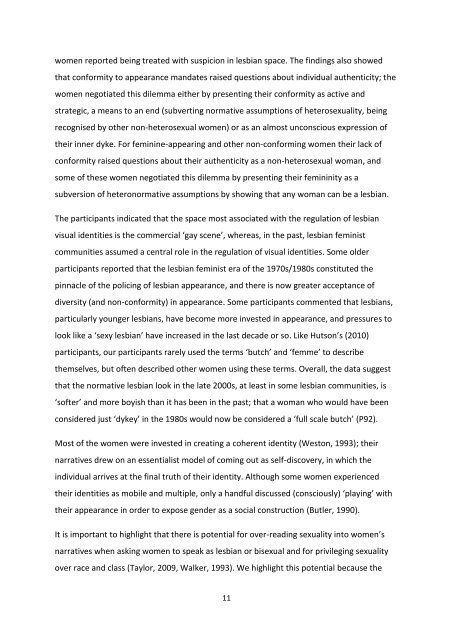Clarke, V. and Spence, K. (2012) I am who I am? Navigating norms ...
Clarke, V. and Spence, K. (2012) I am who I am? Navigating norms ...
Clarke, V. and Spence, K. (2012) I am who I am? Navigating norms ...
Create successful ePaper yourself
Turn your PDF publications into a flip-book with our unique Google optimized e-Paper software.
women reported being treated with suspicion in lesbian space. The findings also showed<br />
that conformity to appearance m<strong>and</strong>ates raised questions about individual authenticity; the<br />
women negotiated this dilemma either by presenting their conformity as active <strong>and</strong><br />
strategic, a means to an end (subverting normative assumptions of heterosexuality, being<br />
recognised by other non-heterosexual women) or as an almost unconscious expression of<br />
their inner dyke. For feminine-appearing <strong>and</strong> other non-conforming women their lack of<br />
conformity raised questions about their authenticity as a non-heterosexual woman, <strong>and</strong><br />
some of these women negotiated this dilemma by presenting their femininity as a<br />
subversion of heteronormative assumptions by showing that any woman can be a lesbian.<br />
The participants indicated that the space most associated with the regulation of lesbian<br />
visual identities is the commercial ‘gay scene’, whereas, in the past, lesbian feminist<br />
communities assumed a central role in the regulation of visual identities. Some older<br />
participants reported that the lesbian feminist era of the 1970s/1980s constituted the<br />
pinnacle of the policing of lesbian appearance, <strong>and</strong> there is now greater acceptance of<br />
diversity (<strong>and</strong> non-conformity) in appearance. Some participants commented that lesbians,<br />
particularly younger lesbians, have become more invested in appearance, <strong>and</strong> pressures to<br />
look like a ‘sexy lesbian’ have increased in the last decade or so. Like Hutson’s (2010)<br />
participants, our participants rarely used the terms ‘butch’ <strong>and</strong> ‘femme’ to describe<br />
themselves, but often described other women using these terms. Overall, the data suggest<br />
that the normative lesbian look in the late 2000s, at least in some lesbian communities, is<br />
‘softer’ <strong>and</strong> more boyish than it has been in the past; that a woman <strong>who</strong> would have been<br />
considered just ‘dykey’ in the 1980s would now be considered a ‘full scale butch’ (P92).<br />
Most of the women were invested in creating a coherent identity (Weston, 1993); their<br />
narratives drew on an essentialist model of coming out as self-discovery, in which the<br />
individual arrives at the final truth of their identity. Although some women experienced<br />
their identities as mobile <strong>and</strong> multiple, only a h<strong>and</strong>ful discussed (consciously) ‘playing’ with<br />
their appearance in order to expose gender as a social construction (Butler, 1990).<br />
It is important to highlight that there is potential for over-reading sexuality into women’s<br />
narratives when asking women to speak as lesbian or bisexual <strong>and</strong> for privileging sexuality<br />
over race <strong>and</strong> class (Taylor, 2009, Walker, 1993). We highlight this potential because the<br />
11

















